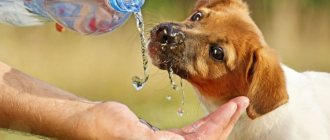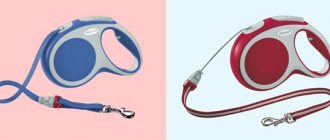When a dog, or any animal, appears in the house, it is important that it does not have diseases. A dog's body can contain many germs and bacteria. Very often, loving owners hug and kiss their pet without thinking about it, and many even forget about washing their hands.
If an animal is sick, the owner begins to worry that he may infect him and the rest of the family. But it happens when it was not the dog who brought the disease into the house, but the owner, and the animal simply became a victim. Therefore, we need to know whether a dog can become infected from a person and what we can inadvertently pass on to it.
Our common diseases
Despite the different structure of the immune system, microflora and body structure, there are still some diseases that we can transmit to our pet. And, although this is a rather rare occurrence, you need to know in order to avoid health problems.
Let's look at the most common and dangerous ones.
- Rabies is one of the most dangerous infectious diseases that can quickly lead to death. Infection occurs when saliva gets on the affected area of the skin and the infection causes great harm to the central nervous system. Of course, mostly people become victims, but there are cases when a person infects a dog.
- Ringworm is a fungus that is spread by direct skin contact with an affected area or other contaminated surface. If the disease is left untreated, it can be easily treated. *
- Tuberculosis is a dangerous infection transmitted by airborne droplets. Dogs are very difficult to treat and due to the increased danger, the animal often has to be euthanized.
- Plague is a viral disease that can quickly lead to death. It is easy to become infected with it, even just by sniffing a carrier. It can be treated, but you can’t hesitate, especially if the dog is young. Adults tolerate this disease much easier.
- Helminthiasis is brought into the body by parasitic cysts, from which, when introduced into a suitable environment, adult individuals hatch and reproduce. The disease can bring a lot of trouble, but it is quite treatable if measures are taken in time.
- Lambiasis is a parasitic disease that can easily be contracted simply by drinking dirty water. These parasites can easily be passed on to a dog.
Etiology of rotavirus infections in dogs
The causative agents of the infectious disease are viruses of the Rotoviridae family. The virus exhibits resistance to acidic environments and can persist for a long period of time in the external environment, frozen parenchymal organs, and feces.
After entering the dog’s body, rotavirus is transported through the bloodstream to the gastrointestinal tract, localized in the cellular structures of the epithelium of the small intestine, causing swelling, destruction of the epithelium, and mucosa. After the accumulation of a large amount of virus on the mucous membrane, the pathogen penetrates the lumen of the duodenum, provoking an inflammatory process and other pathologies.
Rotavirus enters the external environment with feces and feces of infected animals and virus carriers.
Infection of dogs with the rotavirus virus occurs through direct contact of healthy animals with infected individuals, when animals communicate with latent virus carriers, the so-called oral-fecal route. The virus can be carried by rodents, rats, mice, voles, birds, and some types of blood-sucking insects.
Transmission of the virus can occur through household items, care items, dog equipment, bedding, bowls, contaminated water, and food. Predisposing factors are poor living conditions for dogs, especially if animals are kept in groups in enclosures and nurseries. Frequent stressful situations that weaken the animal's body and helminthic infestations can become a predisposing factor for infection.
Can a dog catch a cold from a person?
Any caring owner, feeling the signs of a cold, will think about whether it is worth isolating the pet for a while from the sick person. Will he get sick too? This issue requires attention, since colds are quite common.
An animal can become infected, for example, by drinking cold water or becoming hypothermic in general, thereby weakening the immune system, but it is also possible to become infected through contact with another organism that carries the disease.
There is such a disease as canine flu, it occurs in the same way as human flu, with similar symptoms. Therefore, when the owner and the dog get sick at the same time, it seems that it is the same infection. However, this is not true; it was not the owner who infected the pet, or vice versa. But this is if we are talking about direct transmission of the disease. The owner may have an indirect relationship to the pet’s disease, for example, by bringing a pathogen on clothing or skin after contact with a sick dog. And also, if you take poor care of your pet, feed it incorrectly and do not support its immunity.
A dog cannot catch a cold from a person, just as a person cannot catch a cold from a dog.
Dogs and cats can become infected with coronavirus from people - study
Author:
doctor Smirnov Anton
2 minutes
5209
The scientists analyzed samples taken from 915 dogs and 505 cats during routine veterinary examinations from March to May. For the study, pets were taken from the areas of Italy most affected by the coronavirus, including in families where COVID-19 was confirmed. In total, veterinarians were able to obtain 300 and 180 oropharyngeal swabs, 180 and 80 nasal swabs, and 55 and 30 rectal swabs from dogs and cats, respectively.
PCR tests did not detect coronavirus in any of the animals, which suggests that none of the pets were infected at the time of sampling. However, serological testing revealed the presence of specific neutralizing antibodies in 13 dogs and 6 cats, with 2 dogs and one cat living in homes where no family members were confirmed to have COVID-19. All other pets most likely became infected from their sick owners.
Animals and coronavirus MedNews about what is known about animal infection with COVID-19
Read the article
Scientists also found that all infected pets were over one year old, with males being infected more often than females.
The study authors note that their work confirmed the ability of dogs and cats to seroconvert, that is, produce neutralizing antibodies. Given that dogs were twice as likely to have antibodies, this may indicate their increased susceptibility to infection compared to cats.
Soon after the coronavirus began spreading around the world, animal cases began to be reported in different countries. Yesterday, Japanese news agencies wrote about two cases of confirmed coronavirus in dogs whose owners have COVID-19. In mid-July, a dog named Buddy died in New York, who also had coronavirus and symptoms of the disease. The dog was previously diagnosed with lymphoma, but doctors don't know whether the cancer made him more susceptible to the virus.
It is also known that minks can become infected from humans - large outbreaks of infection occurred at 14 fur-bearing enterprises in Denmark and Holland, after which the authorities of these countries decided to destroy the infected animals. There have also been cases of infection in cats in Hong Kong and tigers at the New York Zoo.
According to Joanne Santini, a microbiologist at University College London, the virus can spread undetected in some animals. “We just don’t have enough data,” says the researcher.
Pathogens often circulate between different species, making it difficult to control the spread of viruses. Humans most likely acquired SARS-CoV-2 from bats, but researchers do not know how many animals were involved in the chain of transmission. At least twelve different animals are known to be susceptible to the coronavirus, including domestic dogs and cats, lions, tigers and farmed minks. This means, for example, that like all animals of the mustelid family - minks, weasels, badgers, wolverines, martens - they can potentially be susceptible to coronavirus and transmit it to people. But until now no one has tested this possibility.
Prevention
It is common knowledge that prevention is better than cure, so try to take care of your dog's well-being in advance. The key to health is a strong immune system, which requires the following conditions.
- Get all the vaccinations recommended by your veterinarian, which will significantly strengthen your immune system and prepare your body for potential danger.
- Proper varied diet with vitamins and dietary supplements.
- Maintaining hygiene. Regularly bathing your dog will prevent bacteria from lingering and causing harm to the body. You also need to comb your dog to avoid hair getting into the digestive and respiratory systems. The animal must have a clean place to sleep.
- Avoid hypothermia or overheating of the dog, avoid drafts.
- Provide the animal with sufficient physical activity - games, walks.
When adopting a dog, it is important to be aware of the responsibility for his health.
An animal is not a toy; it requires a lot of attention and care. If this is not given, it can become a threat to family members and other animals. Therefore, take care of your health and the health of your dog. If someone gets sick, seek help immediately so that no one else gets hurt. Prevention, Dog
Causes of colds in dogs
- not a sufficiently active lifestyle. This behavior reduces the animal's immune barrier. Walk your pet for a long time. If the weather is unfavorable, shorten the time of the walk, but do not abandon it.
- hypothermia. In the cold season, dress your pet in suits if the specifics of the breed require it. Do not allow eating snow, ice or drinking cold water. If the dog lives in a booth, insulate it for the winter. Do not bathe your animal in cold weather. Dogs are afraid of drafts, especially wet dogs.
- balanced diet. This is important for the immune system, which can fail if there is insufficient nutrition without vitamins. In winter, increased nutrition is required. Do not change your diet suddenly.
- vaccinations. Timely vaccinations and a preventive examination by a veterinarian will protect your pet.
From the article you learned that human influenza viruses are not able to infect a dog, but a person can do a lot to protect their pet from getting a cold. If you encounter symptoms in your dog that are similar to a human acute respiratory infection, then do not ignore it, contact your veterinarian.
Post Views: 37
Tags: dogs, dog care
Symptoms of rotavirus infection in dogs
The incubation period for rotavirus infection in dogs ranges from two to three days to a week. The intensity of the manifestation of characteristic clinical symptoms of rotavirus depends on the age, physiological state, age of the animals, and the influence of predisposing factors.
Rotavirus in dogs, especially in small puppies and young animals six to seven months of age, begins acutely. In adult animals, the infection occurs in a subclinical form.
The first, most characteristic sign of rotavirus in dogs at the initial stage is a sharp increase in temperature, fever, chills, and mild symptoms of gastroenteritis. The pet refuses food and favorite treats. Throughout the day, profuse diarrhea, frequently recurring bouts of vomiting, and nausea are noted. The stool acquires a foul odor and a green-yellow color. There is a lot of mucus in the feces, and blood clots are possible.
Symptoms of rotavirus infection in dogs:
- temperature rise to 40-41 degrees;
- a sharp decrease in physical activity, lethargy, apathy;
- the dog shows anxiety, hides in dark corners, whines;
- lies down with his stomach on the cold floor or tiles;
- refuses food, quickly loses weight;
- increased thirst;
- pain in the epigastric region;
- profuse discharge from the eyes and nose;
- anemia of the mucous membranes and palate;
- diarrhea, soft, light yellow stool mixed with mucus.
When palpating the peritoneum, animals whine due to severe pain. In sick animals, enlargement and tenderness of regional lymph nodes, signs of rhinitis, and damage to the respiratory tract are noted. Vomit contains a lot of mucus.
Vomiting and diarrhea lead to weakening and severe dehydration (dehydration) of the body. Dehydration can cause severe shock in a dog and cause death. The death of small puppies during acute rotavirus infection occurs on the second or third day from the moment of infection.
What diseases can a person infect his dog?
Contents hide
We wrote about zoonoses, that is, diseases that humans can contract from animals. However, often the pet owner himself can pose a danger to his four-legged friend, being a carrier of the disease.
Mumps is the same disease that many of us suffered from in childhood. Its pathogen is completely indifferent to whose body it lives in - a human or a dog.
Symptoms of mumps in dogs are similar to humans: fever, inflammation and swelling of the salivary glands (most often the parotid glands), weakness and pain when swallowing. Due to unpleasant sensations in the neck and ears, the animal may refuse to eat and drink.
This disease rarely causes serious damage to a pet’s health, and recovery usually takes 5–7 days.
Tuberculosis poses a much more serious threat to dogs. Although it is difficult to prove the transmission of the causative agent of the disease - Koch's bacillus - from a person to his pet, quite a lot of such cases are known. The pet develops characteristic symptoms: fever, inflammation of the submandibular glands, coughing (in some cases with blood), shortness of breath and rapid weight loss, sometimes diarrhea or vomiting, and non-healing wounds. As is the case with people, the open form of this disease can only be treated in a hospital, but, unfortunately, the prognosis does not leave much hope.
Owners can also infect their dogs with giardiasis , the main symptom of which is diarrhea. True, more often than not, dogs who like to drink from puddles or natural bodies of water infect their owners with it.
of worms, as well as the fungus that causes ringworm, is possible
Its symptoms are less severe in humans than in dogs. If a person develops only red, slightly flaky spots on the skin and the itching of the patient is not particularly bothered, then in the case of our smaller brothers, areas of lichen are very itchy and quickly grow, turning into bald spots.
Until recently, scientists believed that people could not infect their animals with influenza , because the disease is caused by different strains in humans and dogs. But recently this opinion has been refuted. So if you have a cold, it is better to limit communication with pets.
Another frequent “gift” to our four-legged friends is the bacterium Helicobacter pylori , which causes gastritis in both humans and dogs.
What we also have in common is Staphylococcus aureus . In dogs, infection with it is accompanied by symptoms such as fever, diarrhea and vomiting (if the gastrointestinal tract is affected), skin swelling and itching, and inflammation of the mucous membranes.
However, staphylococcus is not the only microorganism that people are able to transmit to their tailed friends. In addition to it, chlamydia and mycoplasma , although scientists have not yet come to a consensus regarding the possibility of transmitting the latter. However, both bacteria cause severe damage to the body in dogs.
Human salmonellosis . Its symptoms are vomiting, diarrhea and fever. But unlike their owners, in dogs this disease can be asymptomatic or develop into a chronic form. In some cases, it can even be confused with tuberculosis.
This is not a complete list of diseases that an owner can infect their dog with. However, they are among the main and most common.
Photo source:











